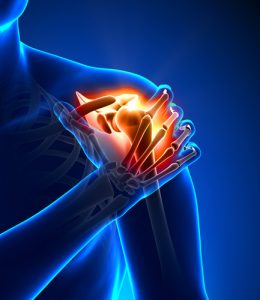Does High Cholesterol Impact Rotator Cuff Healing After Surgery?
Rotator cuff tears are a common condition that cause pain and functional disability. About half of the general population older than 60 years of age has either a partial or full thickness rotator cuff tear and they are completely asymptomatic.
Surgery to repair the rotator is widely practiced and has been commonly accepted for treatment of full thickness rotator cuff tears or partial thickness rotator cuff tears greater than 50%. Despite the fact the surgeon performs an excellent surgery, 20 to 94 percent of rotator cuff repairs do not heal or they re-tear.
Researchers Conduct Study to Understand Impact of High Cholesterol and Rotator Cuff Repair
Dr. Chung performed a study looking the relationship between high cholesterol and rotator cuff repairs. He wanted to understand whether cholesterol levels play a role in reducing rotator cuff healing after surgery. The author published the study in the American Journal of Sports Medicine, May, 2016. It was a lab study performed with rabbits.
 Researchers note that fatty infiltration is one of the most important prognostic factors for anatomic and functional outcomes after rotator cuff surgery. The surgical repair of the torn rotator cuff may not be able to stop or reverse the process of fatty infiltration. Fatty infiltration is when the rotator cuff tendon and muscle turns to fat.
Researchers note that fatty infiltration is one of the most important prognostic factors for anatomic and functional outcomes after rotator cuff surgery. The surgical repair of the torn rotator cuff may not be able to stop or reverse the process of fatty infiltration. Fatty infiltration is when the rotator cuff tendon and muscle turns to fat.
Interestingly, a high serum cholesterol concentration greater than 240 mg/dL also occurs typically in people’s legs right around when there was a high incidence of rotator cuff tears. They thought that possibly this was a metabolic risk factor.
What the researchers found is that if they reduced the high cholesterol in the blood level, it would promote rotator cuff healing.
Study Overview: High Cholesterol and Rotator Cuff Repair Surgery
The authors used the series of 48 rabbits that were randomly allocated into four groups. After four weeks of a high cholesterol diet in group A and group B, and a regular diet in group C and group D, the supraspinatus tendon was detached. That is, the rotator cuff was torn and left alone for six weeks, and then it was re-torn in a transosseous manner. This is the common way the rotator cuff is repaired in groups A and B which was a group that had the high cholesterol diet, and group C which was a group that had a regular diet. They used group D as a control.
Group A continued to receive the high cholesterol diet until the final evaluation six weeks after the repair. Group D was changed to a general diet with administration of a cholesterol lowering agent-simvastatin.
Researchers then performed histological evaluation of fat to muscle proportion. They found that high cholesterol levels had a deleterious effect on fatty infiltration. Additionally, lowering cholesterol seemed to hold or reduce the harmful effects in the experimental model based on the quality of tendon-to-bone repair.
This study suggests that more needs to be done to understand the relationship between high cholesterol and rotator cuff repair. The conclusion of the study was that systematic diseases such as high cholesterol may need to be tightly controlled through the preoperative period of rotator cuff repairs.

Recent Comments